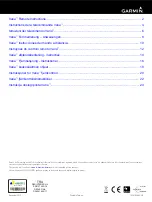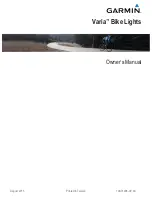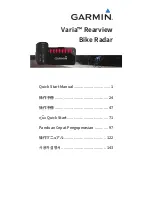
18
Once one side of the tire is inserted in the rim, check to make sure the valve stem lines up properly and the tube is
smooth across the rim and inside of tire. The tube should not be bunched up in any area.
Where the tube valve is, slide the second wall and bead of the tire into the edge of time rim. Follow pushing the tire
wall and bead into the inside edge of the rim.
You will get to an area of only a few inches left and you will need to apply pressure to push the tire side wall and
bead behind the edge of the rim.
Once the tire is fully inserted, check for any areas on both sides if the tube is exposed. The tube must not get
trapped between the tire bead and rim edge.
Locate the tube valve and use your hand to push on the tire on the outside of the valve to help push the valve
further out through the rim.
Fill the tube with 50% air and then check the tire bead and rim edge again to see if the tube is protruding anywhere.
Once you confirm the tube is not protruding, you can fill the tire to your desired air pressure.
You are now ready to install the wheel back onto the bicycle according to the previous sections.
Chapter 7: Maintenance and Replacement
Your new Storm was designed for ease of use and owner servicing. There are no tasks which require advanced skills.
Most maintenance and replacing of parts were designed to be accomplished by the typical bicycle rider. Please read this
section to learn how to keep your Storm performing like new.
a)
Keeping your bike clean
Your new Storm is an outdoor friendly electric bicycle but should be kept clean and free from dirt. Dirt on and around
seals and drive train components can cause premature wear and dirt on paint and part finishes can cause premature
aging. If storing your bicycle outdoors under the elements, you must keep it covered with a high quality bicycle cover to
avoid rain, snow or dirt damaging your new bicycle.
To clean your bicycle, follow these instructions:
Your bicycle incorporates electrical components; it is advised when washing your bicycle you should first
cover the throttle and battery base. Use a plastic bag or a piece of plastic wrap to cover the components.
Place the bag or wrap around the complete throttle assembly and use a rubber band or tape to secure. The
battery should be removed prior to cleaning and a plastic bag or wrap secured by tape can be used to cover
the battery base. If you are planning for a ride after washing, it is recommended the saddle also be covered.
The saddle has miniature holes where there is stitching and water can seep into these small holes.
To wash your bicycle you will need a small bucket of warm water with car soap, sponge, small brush, chain
lube and a few rags or towels.
Rinse your bicycle off with a light spray of water to remove any dirt on the surface. Using the sponge and
warm soapy water, wash the frame and frame components which include the forks, handlebar and seat
post. Start from the top of the bicycle working your way down.
Once the frame is washed, use the sponge to clean the motor, spokes, chain guard and rims.
The tires, pedals, crankset and chain will be the remaining items needing to be washed. Use the brush first
on the tires and then the pedals. Rinse the brush and then using the warm soapy water, clean the chain
ring, freewheel and finally the chain. If the chain and drive train are very dirty or greasy, a bicycle degreaser
should be utilized.
After washing, spray the bicycle down with fresh water.
Use the rags or towels to dry off the bicycle. Start by drying the frame first, followed by the components, the
wheels, tires and then the drive train.
Once the drive train is dry, use a chain lube to lubricate the chain.
b)
Avoid scratching your bike
Your new Storm is a high quality bicycle has been designed to withstand the elements by utilizing stainless steel, anodized and
painted aluminum alloys, brass plus galvanized or painted metals. Stainless steel and brass are used in their natural forms and
can withstand the elements with no additional protection required. The majority of your bicycle however is fabricated from
aluminum alloys which have either a painted finish or have been anodized. Aluminum does not rust but can discolor and
corrode over time. The frame has a 3 layer paint finish which protects the aluminum and graphics. Components such as the
handlebars, crank arms, chain guard, seat post and more have been anodized through an electrolytic process which increases
corrosion and wear resistance. If the frame or components become scratched, these items could slightly corrode around the
scratched area. Depending on the care of your bicycle, a scratch could take month or years for corrosion to appear. To
maintain future value and years of beauty, it is best to be careful when folding and moving your bicycle not to scratch the metal
surfaces. If a surface is scratched, use clear nail polish or black nail polish to cover and seal the scratch.
c)
Brake Bed-In and adjustments
Both brakes on your Storm
are high performance Avid BB5 disc brakes. The front and rear brakes includes inboard ―Tool Free‖
adjusting knobs and barrel adjusting knobs at the caliper for outboard pad adjustment. They have powerful stopping power but
must be properly adjusted. Adjusting your brakes will be required from time to time due to either the brake pads wearing or the
brake cables stretching. Both front and rear brake systems are easy to adjust with multiple adjusting points. Please follow the
instructions below on how to adjust your brakes. You can also review the included Avid BB5 guide included with your starter kit. If
you are unsure as to a component or installation procedure, please contact your local authorized dealer or Prodeco Technologies.
AVID SAFETY INFORMATION
Brakes are a safety-critical item on a bicycle. Improper setup or use of brakes can result in loss of control or an accident,
which could lead to a severe injury.
Avid brakes are a performance product that offers increased stopping power over brakes that you may be used to. This
greater power requires less effort to lock-up a wheel when braking. A wheel lock up might cause you to lose control and
possibly cause injury.
It’s your responsibility to learn and understand proper braking techniques. Consult the owner’s manual for your bicycle
and a professional bike dealer.













































